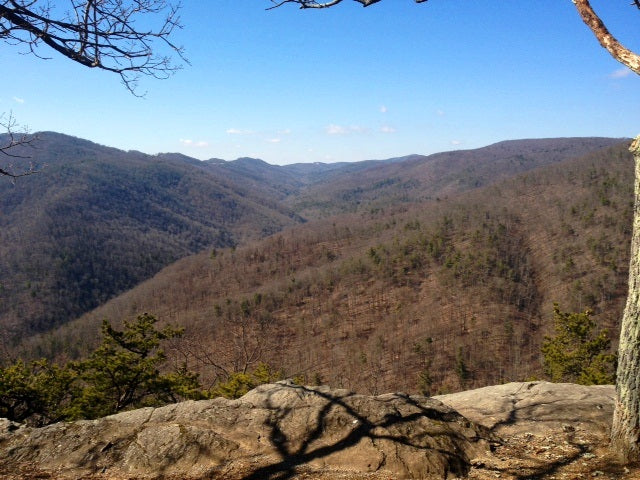Testing in measured and controlled environments has become a mandatory part of the game, but can never fully replace real world testing. Your butt can tell you things that machines have a hard time measuring, and don't translate well to the x and y axis. Sometimes you've got to load up the wagon and get some quality time in the saddle in order to see how things line up.
We've been interviewing frames to be the successor to the Wheelhouse. The Wheelhouse is a lot to live up to, but we think we've got a good candidate. I've been riding it for a few weeks, but a bad winter cold cost me some valuable time on it. Last week made up for that, with 160 miles of riding over 3 days, including about 16,000 feet of climbing. Mike and I are distinctly complementary riders, which serves us well, and it doesn't hurt that we can ride the same size bikes which makes it easy to compare notes. His turn comes next.
 Mile 19 on the Blue Ridge Parkway in VA
Mile 19 on the Blue Ridge Parkway in VA
The terrain I rode gave a great overview of how the bike responded to different challenges. From 50 mph winding descents to grinding "why didn't I put a 27 on????" steepness to crit-like turns to power climbs, I saw it all. I don't want to go too deep into the details but it did a lot of things remarkably well, and there was one thing on which I need a second opinion.
One thing that jumped out is the frame's comfort. Using wheels and saddle/post swapped over from my Wheelhouse, and everything else set up as closely as possible, it was easy to notice that I wasn't getting beaten up. The first and third days of the trip were long days on the mountain bike, 3 hours the first day and just over 2 the other. Mountain biking really gets to my lower back after a while, and I was sure that by the end of the trip my lower back would be in traction. This wasn't the case at all. The back end of the frame I was on is very resilient. It also generally turns as well as any bike I've been on, but we might need to switch from the lighter fork to the stiffer fork to see everything the bike's capable of. The whole package is crazy light as is - with Force, alloy cockpit, alloy clincher wheels, pedals, and cages the thing barely cracked 15 pounds - so adding a few grams to stiffen the fork seems worth pursuing almost in any case.  It's a LONG way to the top.
It's a LONG way to the top.
The other thing I wanted to give a good look into was spoke type and tension on mountain bike wheels. My wheels for last season were 28/28 with Laser spokes, and did well through about 50 hours of riding and racing. They performed great and held up well, but weren't fully zero maintenance (I gave them a midseason touchup). At 165, I'm just north of middle-weight, and a touch harsher on wheels than the average bear. I wanted to see how a 32/32 build with Lasers would do, and while I only got about 5 hours in on them, they were 5 hard hours of wheel torture - the video understates both steepness and rockiness. Rocks, rocks, and more rocks. This isn't a buffed-out, bermed IMBA roller coaster track. The wheels are as true as when they left the stand after what beating I was able to give them, and gave me a better read on when to recommend which lacing. The other thing on my mind is that wheels used with tubeless setups definitely want a bit more spoke tension - going tubeless drops the spoke tension noticeably, which can lead to bad things. Of course too much spoke tension has its own problems, that's why wheelbuilders make the huge dollars, right?[youtube https://www.youtube.com/watch?v=HMi3T-sFH3k&w=420&h=315]

4 comments
No complaints with the Wheelhouse at all, and I personally have probably not pushed it anywhere close to its limits. I just thought that maybe the successor was heading in the direction of being a lighter racing frame than the Wheelhouse.Though after watching the various cobbled classics last year, and my own endeavors, roads bikes are much more resilient than I had previously perceived.
Ike – East coast, this is what it's like. Don't worry, though, none of the races are that rocky. Or that steep.Mike – Don't confuse strength with rigidity. The force you put on a fork in a 27 mph turn where you are countersteering like a mofo and trying to break your outside pedal off doesn't have huge overlap with what one does on a gravel road. Also, it's not possible that you've found the Wheelhouse fork under-gunned is it? That thing is a freaking i-beam.My back issue is mostly from short standing climbs, which CX uncovered most of all. It's less of a percussion thing and more of a muscular strain deal. Time to step up the hated strength training regimen.
I for one would prefer a slightly beefier fork, but then again I do crazy stuff like take my road bike on dirt roads on occasion in events like the Alpine Loop Gran Fondo or the Winter Bike League rides. And of course there is always Poolesville…I also have lower back issues on my hardtail, generally at race pace or rides longer than 2 hours due to the increased beating I take, so got a Full-Sus for those occasions. No more lower back issues.
Are you sure that was an actual trail and you weren't just picking a random path through the woods? That looks ridiculous to me, and Austin has some pretty rocky trails.